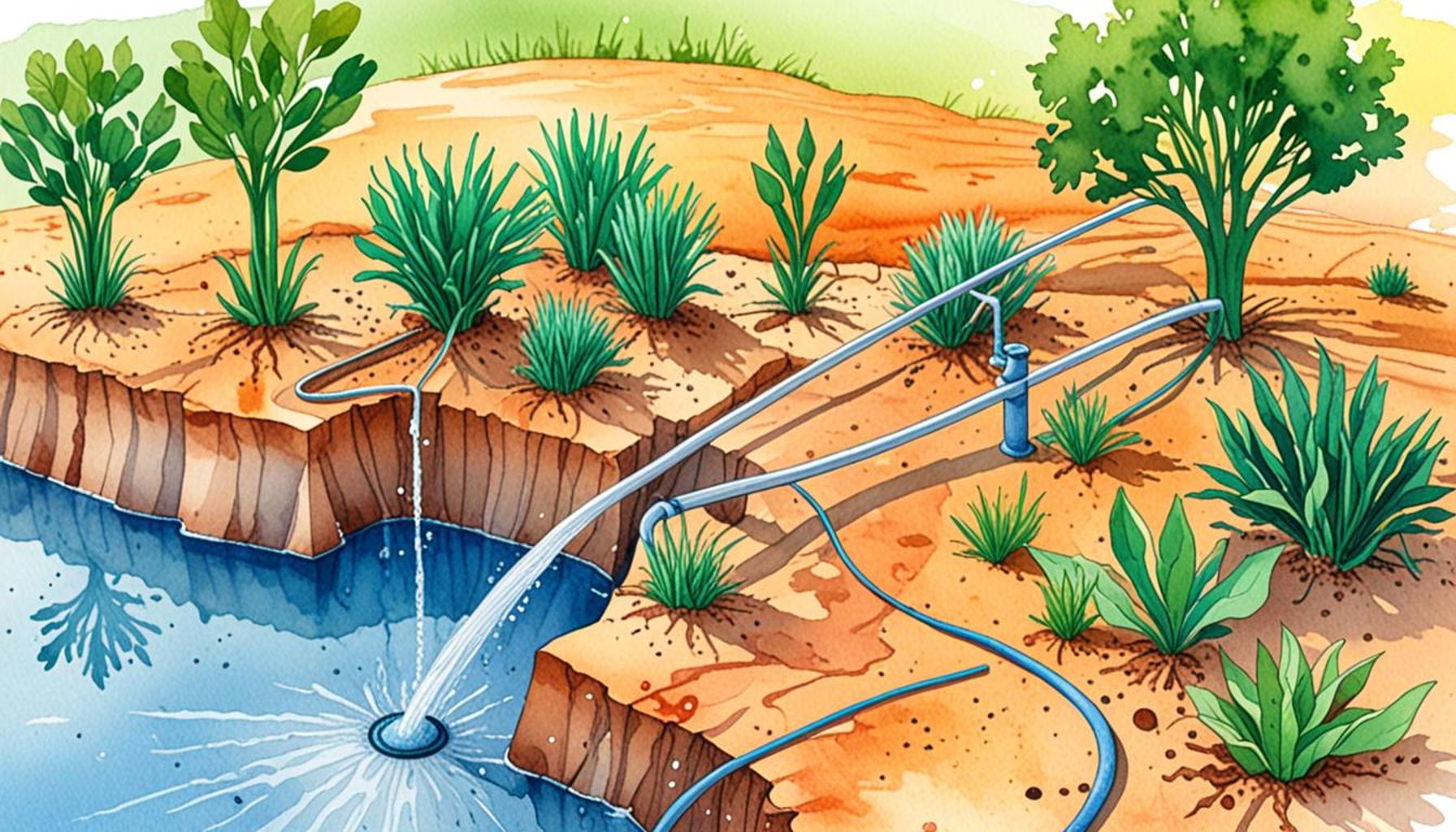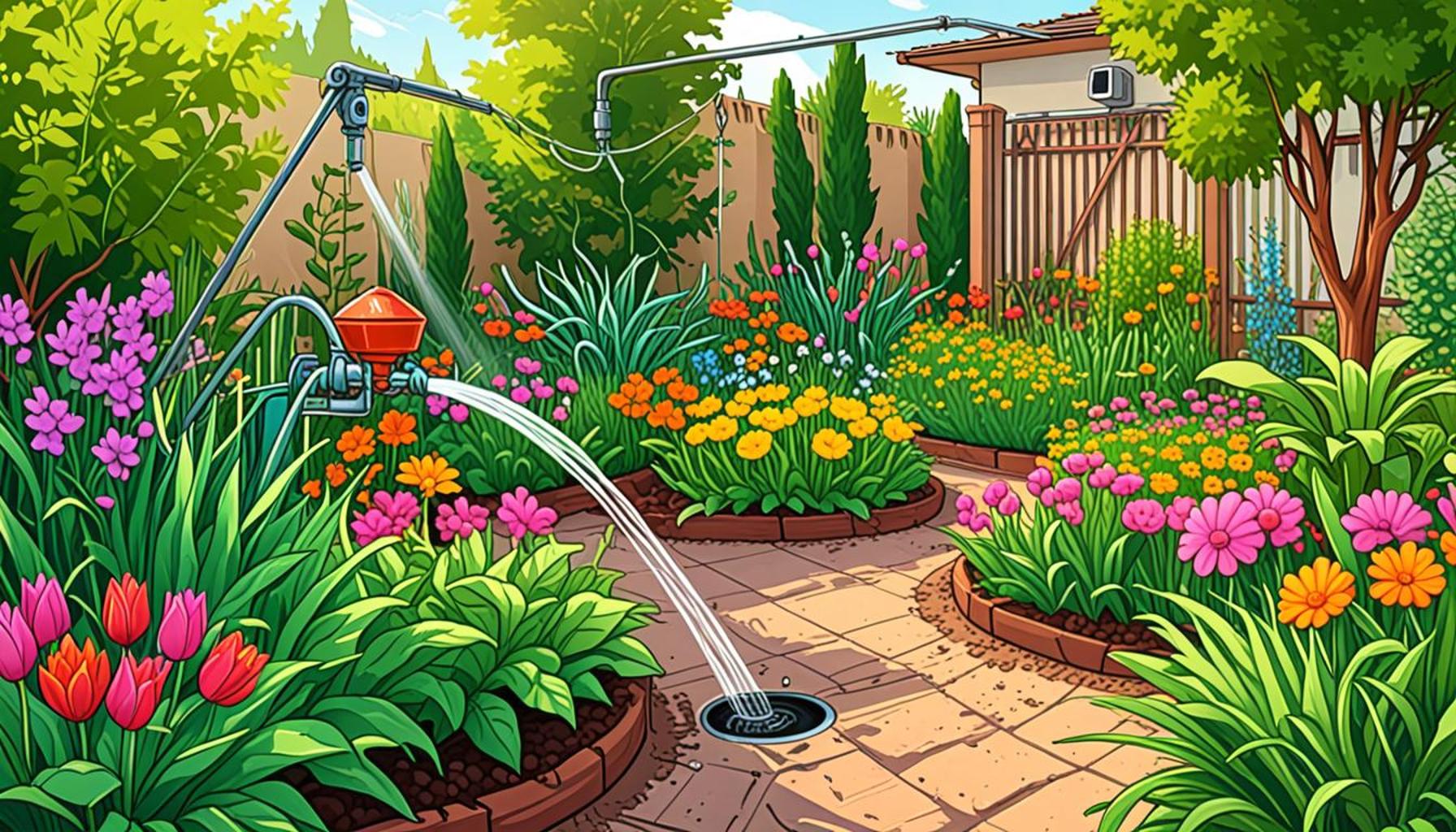Capillary Irrigation: Harnessing Soil Water for Sustainable Growth

Innovative Solutions for Water Management
As global water crises loom larger, innovative solutions have become crucial in the fight against water scarcity. One particularly intriguing method gaining traction is capillary irrigation. This cutting-edge technique allows plants to efficiently absorb moisture directly from the soil without the extensive use of traditional irrigation systems, making it a game changer for sustainable agriculture.
Capillary irrigation functions by utilizing the natural wicking ability of soil, which can draw water upwards through micro-pores. This process is particularly advantageous in regions afflicted by drought or scarce water supply, such as the arid Southwestern United States. By optimizing how plants extract moisture, this method not only conserves water but also enhances the resilience of crops. For instance, farmers in California have begun to implement capillary irrigation in vineyards, resulting in not only reduced water usage but also improved grape yield quality.
Key Benefits of Capillary Irrigation
- Efficiency: Capillary irrigation minimizes water loss due to evaporation, making it far more efficient than conventional irrigation methods, which often lead to significant water waste.
- Soil Health: This technique nurtures healthier root systems by providing consistent moisture at a controlled rate, fostering a more robust growth environment for plants.
- Cost-Effective: Farmers can significantly reduce their reliance on costly traditional irrigation systems, leading to lower water bills and streamlined farming practices.
Increasingly, farmers are recognizing the importance of sustainable practices, and capillary irrigation is emerging as a vital strategy. By harnessing available soil moisture, this approach not only conserves precious water resources but also guarantees vigorous crop growth, which is essential for food security.
Potential for Broader Application
The scalability of capillary irrigation is particularly promising with the advancements in agricultural technology. It holds significant possibilities not only for large-scale farms but also for urban gardening initiatives and small-scale agriculture in diverse settings. For instance, community gardens in urban areas could benefit from capillary irrigation systems to make efficient use of limited water resources.
In a world grappling with the challenges of climate change and increasing population demands, understanding and implementing capillary irrigation may very well be key to fostering a more sustainable future. By exploring such innovative techniques, we can find solutions that address immediate agricultural needs while also preserving the environment for generations to come.
DISCOVER MORE: Click here to learn how soil cover can enhance your gardening
Understanding the Mechanics of Capillary Irrigation
Capillary irrigation is a fascinating technique that hinges on the fundamental principles of soil physics, particularly the concept of capillarity. This natural phenomenon refers to the ability of water to move through small spaces, such as the pores in soil, even against the force of gravity. The tiny water pathways created by the soil’s structure allow moisture to migrate upward to the plant roots, providing them with a steady supply of hydration. This mechanism is especially beneficial for plants with shallow root systems, which can struggle to access deeper water sources.
The effectiveness of capillary irrigation can vary significantly depending on soil composition and structure. Some soils, like sandy soils, have larger particles and larger spaces between them, which results in rapid drainage and less capillary action. Conversely, clay soils possess smaller particles and tighter bonding, facilitating better water retention and optimizing capillary movement. This variation emphasizes the need for tailored irrigation solutions that consider local soil characteristics. For example, farmers in the Midwest have seen success implementing capillary irrigation in clay-rich areas that naturally retain more moisture, leading to healthier crops.
Implementation Strategies for Capillary Irrigation
Implementing capillary irrigation does not necessarily require extensive modifications to existing agricultural practices. There are several strategies farmers can employ to effectively harness this method:
- Mulching: Applying organic materials, like straw or wood chips, on soil surfaces can significantly reduce evaporation while promoting a consistent moisture level beneath.
- Soil Amendments: Adding compost or other organic matter can improve soil structure, enhancing its water retention capabilities and supporting capillary movement.
- Sub-surface Irrigation: Integrating sub-surface systems, such as drip tubes, can work synergistically with capillary action, delivering water directly to the root zone.
These strategies not only optimize the benefits of capillary irrigation but also integrate seamlessly with conventional agricultural practices, minimizing disturbance to the soil ecosystem. By adopting such measures, farmers can further optimize water usage, ensuring that every drop counts.
Moreover, farmers are beginning to utilize technology, such as soil moisture sensors and automated irrigation systems, to monitor and manage capillary moisture levels more effectively. These innovations allow farmers to make data-driven decisions that enhance their water conservation efforts while maintaining crop productivity.
In conclusion, understanding the dynamics of capillary irrigation reveals its vast potential to redefine water management strategies in agriculture. By tapping into the natural wicking properties of soil and employing intelligent techniques, growers can ensure sustainable growth and resilience in the face of water scarcity. With continued research and adaptation, the future of agriculture could very well be rooted in the soil’s ability to nourish itself.
Capillary irrigation is an innovative approach that takes advantage of the natural properties of soil to optimize water usage, resulting in a system that not only promotes sustainability but also boosts agricultural productivity. This technique relies on the principle of capillarity, where water is drawn up from a water source through the soil, ensuring that plants receive the moisture they need while minimizing waste. By harnessing this method, farmers can reduce reliance on traditional irrigation practices that often lead to waterlogging or over-saturation of the soil.One of the most compelling advantages of capillary irrigation is its efficiency in water management. With its ability to utilize natural soil moisture, this method significantly lowers the amount of water needed for irrigation compared to conventional systems. Additionally, it promotes healthier root growth, as plants are encouraged to develop deeper root systems in search of moisture, ultimately leading to improved resilience against drought conditions. Through this sustainable approach, farmers are better equipped to adapt to the challenges posed by climate change.Furthermore, capillary irrigation contributes positively to the environmental landscape. By reducing surface runoff and preventing soil erosion, it protects precious topsoil and maintains soil health. The controlled water distribution not only fosters the growth of crops but also helps maintain an ecosystem balance, promoting biodiversity in agricultural settings. As more farmers begin to explore this cost-effective and eco-friendly option, the shift toward sustainable agricultural practices gains momentum, paving the way for a greener future.
| Advantages | Description |
|---|---|
| Water Efficiency | Utilizes natural soil moisture, minimizing waste and reducing irrigation needs. |
| Soil Health | Prevents erosion and maintains topsoil integrity, essential for sustainable agriculture. |
The future of agriculture may very well depend on embracing such sustainable practices. Moreover, the integration of capillary irrigation systems can lead to newfound opportunities for crop diversification, which can enhance the economic viability of farming enterprises. As we continue to delve deeper into the methodologies and technologies surrounding capillary irrigation, we uncover new avenues for efficiency and sustainability that can transform the landscape of agriculture as we know it.
DON’T MISS: Click here to learn how to optimize your garden’s output
The Role of Capillary Irrigation in Sustainable Agriculture
As the world grapples with increasingly unpredictable weather patterns and dwindling water resources, capillary irrigation emerges as a pivotal technique for sustainable agriculture. Not only does this method conserve water, but it also promotes healthier plant growth and soil health—fundamental components for future food security.
Recent studies indicate that implementing capillary irrigation practices can lead to significant reductions in water usage. For instance, the U.S. Department of Agriculture (USDA) reported a 30% decrease in water consumption when farmers adopted capillary irrigation systems alongside mulching and soil amendment practices. This efficiency is vital for regions experiencing persistent drought conditions, particularly in the western United States where water scarcity is an ongoing concern.
Case Studies and Success Stories
Several farmers across the United States have embraced capillary irrigation, witnessing transformative results. In California’s San Joaquin Valley, a farmer implemented a capillary irrigation technique with subsurface drip tubing, combined with organic mulching. This strategy not only conserved water but improved crop yields for almonds and grapes, which are crucial to the state’s economy. His ability to maintain high productivity while managing limited water resources serves as an inspiring model for others in arid regions.
Moreover, the Midwest has also showcased the viability of this method. A study conducted by agricultural researchers from the University of Illinois highlighted that farms employing capillary irrigation techniques in their corn and soybean fields observed enhanced root development, leading to stronger plants that are less susceptible to pests and disease. This highlights not only the immediate environmental benefits but the long-term sustainability of crop production.
Challenges and Limitations
<pDespite its advantages, capillary irrigation is not without its challenges. The initial setup can require adjustments to existing farming practices and may necessitate investment in soil analysis and irrigation infrastructure. Furthermore, farmers in sandy soils can encounter difficulty since these soil types do not retain moisture efficiently for capillary action to be maximized. Thus, integrating capillary irrigation into sandy terrains may call for additional materials like compost or perlites to enhance moisture retention.
Understanding local conditions and conducting thorough soil assessments are critical steps that can pave the way for successful implementation. Collaborations with agricultural extension services or universities can provide invaluable insights, especially for farmers new to this irrigation method.
Future Perspectives on Capillary Irrigation
The potential for capillary irrigation to influence sustainable agricultural practices significantly lies in innovation and education. With advanced technologies like moisture sensors becoming more accessible, the ability to adapt irrigation practices based on real-time data empowers farmers to make informed decisions. Moreover, ongoing research into soil health and the interactions between microbial ecosystems and capillary irrigation could lead to even more refined practices.
Through workshops and community outreach programs, farmers can share knowledge and experiences about their successes and challenges with capillary irrigation. By fostering a collaborative atmosphere, the agricultural community can build resilience and adapt to ever-changing environmental conditions.
As more individuals engage in practices like capillary irrigation, the potential for a shift towards sustainable agriculture becomes increasingly viable. It represents not just a method of watering crops, but a comprehensive approach to nurturing the land, conserving invaluable water resources, and ensuring a stable food supply for generations to come.
LEARN MORE: Click here for essential harvesting techniques
Conclusion: The Path Forward with Capillary Irrigation
The significance of capillary irrigation in fostering sustainable agricultural practices cannot be overstated. As we navigate the challenges of climate change, reduced water availability, and the increasing demand for food, this innovative irrigation method holds great promise for transforming traditional farming systems. With demonstrated successes across various landscapes in the U.S., from the San Joaquin Valley to the Midwest, it serves as a testament to the power of harnessing natural soil processes to optimize water use and enhance soil vitality.
Moreover, the potential of capillary irrigation lies not only in its efficiency but also in its adaptability to a range of soils and climates. By leveraging modern technologies like moisture sensors and incorporating best practices from research, farmers can truly maximize the benefits of this irrigation technique. The collaborative efforts of agricultural communities, research institutions, and extension services are crucial to overcome initial challenges, and the nurturing of local expertise can bolster sustainable practices on a broader scale.
Ultimately, as we reconsider our approaches to agriculture in the face of global challenges, capillary irrigation exemplifies a harmonious blend of tradition and innovation, encouraging us to cultivate a resilient future. The shift towards sustainable growth lies in the hands of farmers willing to embrace these methods—ensuring that future generations will not only have access to rich harvests but also a thriving, healthy ecosystem. Continual exploration and education in capillary irrigation will pave the way for a more secure and sustainable agricultural landscape in the United States and beyond.


